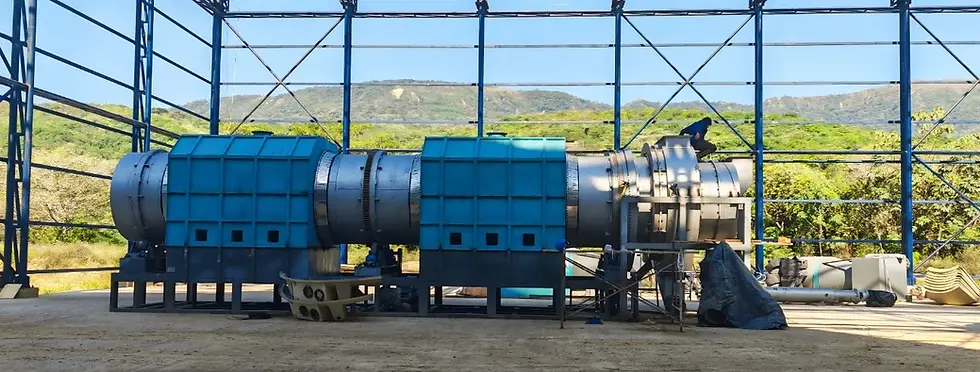How to Maximize the Profit of the Tire-to-Oil Machine: Exploiting the High-Value rCB Market
- lee784287
- 9月16日
- 讀畢需時 4 分鐘
The tire-to-oil machine is revolutionizing the recycling industry, turning waste tires into valuable resources. Among the outputs produced in this process, one of the most valuable by-products is Recovered Carbon Black (rCB). This material, a high-quality carbon black, has significant industrial demand, especially in the automotive and manufacturing sectors. If you are running or planning to invest in a tire-to-oil machine, understanding how to maximize profits from rCB can set you apart in a competitive market. Here's how to strategically capitalize on the high-value rCB market to boost your bottom line.
Understanding the Tire-to-Oil Process and rCB
Before diving into profit-maximizing strategies, it’s important to have a basic understanding of how the tire-to-oil machine works and how rCB fits into the equation.
A tire-to-oil machine typically operates using pyrolysis, a thermochemical process where waste tires are heated in the absence of oxygen. This process breaks down the tires into three primary products:
Tire Oil: A liquid fuel that can be refined or used in industrial applications.
Steel Wire: Extracted from the tires, which can be sold for scrap.
Recovered Carbon Black (rCB): A valuable material used in various industrial processes, especially in the manufacturing of new tires, coatings, and plastics.
Of these, rCB has emerged as a high-value commodity, especially because it is a sustainable alternative to virgin carbon black, which is typically made from petroleum-based feedstocks. As the global push for sustainability continues to grow, the demand for rCB is poised to increase, making it an essential focus for maximizing profits.

1. Invest in High-Quality rCB Production
The quality of rCB produced depends largely on the type of tire-to-oil machine used and the process parameters. To produce high-quality rCB that meets industry standards, consider the following:
Precise Temperature Control: During pyrolysis, maintaining optimal temperatures is crucial for producing a high-quality rCB. Machines with advanced temperature control systems can ensure that the carbon black is not overly oxidized or contaminated, which can reduce its value.
Post-Processing Techniques: After the rCB is produced, certain post-processing methods like sieving, grinding, or activation can further enhance its quality. Many buyers in the market are looking for rCB that can be directly used in production without extensive further processing, so producing a premium-grade product can significantly increase its sale price.
2. Understand and Target Key Industries
To effectively sell rCB, it’s essential to understand the industries that use this material and the specific demands within those sectors. rCB has multiple applications, including:
Tire Manufacturing: The most common use of carbon black, including rCB, is in the production of new tires. This is a large market that can offer substantial demand. rCB can be used as a reinforcing filler in tire manufacturing, making it an attractive alternative to virgin carbon black due to its sustainability factor and cost-effectiveness.
Plastics and Coatings: Carbon black is also widely used in plastic and coating industries for pigmentation and reinforcement. As the world shifts towards more sustainable materials, these industries are increasingly turning to rCB as an eco-friendly option.
Rubber Products: Beyond tires, carbon black is used in the production of various rubber goods, including seals, gaskets, and hoses. The demand for rCB in this market is growing as manufacturers look for greener alternatives to traditional carbon black.
By identifying these key industries and targeting the right customers, you can increase the volume of rCB you sell and secure higher prices.
3. Develop Long-Term Contracts with Buyers
While spot sales might offer quick returns, establishing long-term contracts with buyers in the rCB market can provide a more stable and profitable revenue stream. Many companies, particularly those in the tire or plastic manufacturing industries, prefer consistent suppliers of rCB to avoid the volatility of the market.
To secure these contracts:
Ensure Consistent Quality: Quality consistency is key to establishing long-term relationships. Buyers will appreciate knowing that they can rely on your rCB to meet their specifications on an ongoing basis.
Offer Competitive Pricing: If you can consistently offer a competitive price without compromising quality, you’ll be more likely to attract long-term business partnerships.
Flexible Supply Options: Offering flexible delivery terms, such as large or small batch deliveries, can also make your business more attractive to potential buyers.
4. Leverage the Growing Demand for Sustainability
The increasing demand for sustainable products presents a significant opportunity to capitalize on the high-value rCB market. Many companies, particularly in the automotive, plastic, and rubber sectors, are shifting their supply chains to be more eco-friendly and are actively seeking sustainable alternatives to virgin carbon black.
To capitalize on this trend:
Highlight the Environmental Benefits: Promote the environmental benefits of rCB, such as its role in reducing waste, lowering carbon emissions, and decreasing reliance on fossil fuels. This messaging can attract buyers who prioritize sustainability in their operations.
Seek Certification: Certifications like ISO 14001 (environmental management) or other sustainability credentials can help bolster the appeal of your rCB, making it more attractive to environmentally-conscious buyers.
5. Optimize Operational Efficiency
Maximizing profit doesn’t only rely on finding high-value markets but also on optimizing your production process to minimize costs. Here are some ways to improve operational efficiency:
Regular Maintenance: Ensure that your tyre oil plant is well-maintained to avoid costly downtime and inefficiencies.
Energy Efficiency: Look for ways to reduce energy consumption during the pyrolysis process. Some machines are designed with energy recovery systems that can help reduce operating costs.
Scale Production: Larger-scale operations often benefit from economies of scale, reducing the cost per unit of rCB produced.
Conclusion
Maximizing profits from your tire-to-oil machine requires a strategic approach to producing and marketing rCB. By focusing on high-quality production, targeting key industries, developing long-term buyer relationships, capitalizing on sustainability trends, and optimizing operational efficiency, you can significantly boost your profitability. As the market for rCB continues to expand, now is the time to position your business for long-term success in this high-value, eco-friendly market.


留言